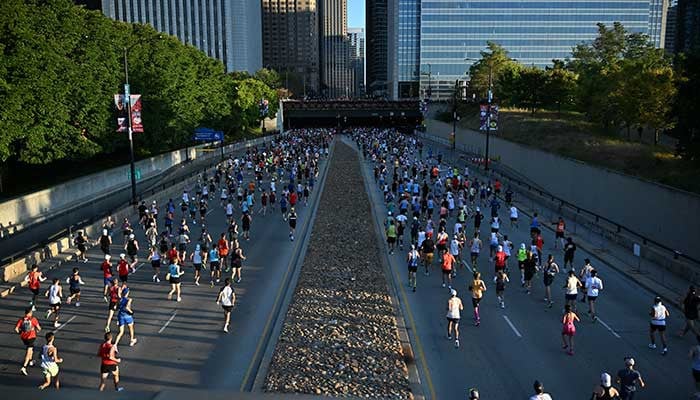KARACHI: Climate change is not only having far-reaching adverse effects, but is also impacting the sport by rapidly reducing the number of ‘cool days’ in which marathon runners can achieve their best performances. This poses an increasing challenge for athletes and organizers of the world’s most important endurance races.
The report, titled “Running out of cool days: How climate change is reducing the odds of optimal marathon conditions,” was released by Climate Central ahead of the New York City Marathon.
It examines how rising global temperatures are affecting marathon performance conditions in 221 global races, including all seven Abbott World Marathon Majors.
According to the study, 86% of marathons analyzed (190 out of 221) are expected to experience a decline in the likelihood of ideal running temperatures by 2045. This includes all the major races in Tokyo, Boston, Berlin, Chicago, London, New York and Sydney.
Among elite male runners, Tokyo currently offers the best chances of ideal race day conditions, with a 69% chance of hitting the “sweet spot” for performance. But that advantage won’t last: the probability is expected to drop by 12 percentage points to 57% by 2045 if emissions continue at current rates.
Elite women, who perform better in warmer temperatures than men, are slightly more resilient to climate changes. They currently have a 78% chance of optimal race-day temperatures in Tokyo, rising slightly to 85% by 2045. Yet researchers emphasize that even small changes in average conditions could have significant impacts on elite performance and racing safety.
The analysis also found that London currently offers the most favorable conditions for elite women, with an 87% chance of optimal temperatures, while Berlin offers one of the least favorable prospects. By 2045, the chance of ideal conditions for top female runners in Berlin is expected to drop from 40% to 29%.
It points out that exceptional heat during the 2025 Tokyo and Berlin marathons pushed conditions well beyond the optimal range for both recreational and elite runners, and that human-induced climate change made these temperatures significantly more likely.
On March 2, 2025, the day of the Tokyo Marathon, the average temperature was 15.2°C (59.4°F), about 8.2°C warmer than normal, and reached a Climate Shift Index (CSI) level of 3, meaning the unusually warm conditions were three times more likely to be due to climate change.
Similarly, the race in Berlin on September 21, 2025 saw an average temperature of 20.7°C, about 6.7°C warmer than normal, with a CSI level of 2, indicating that the heat was twice as likely to be due to global warming.
“Heat waves are already rewriting racing history,” Climate Central said in its press release. “For many marathons, previously ideal racing conditions have become the exception rather than the rule.”
Researchers identified precise marathon temperature sweet spots where runners perform their best. For elite men, that optimal average is 4°C; for elite women it is 10°C. Recreational runners perform best at slightly higher temperatures, around 6°C for men and 7°C for women.
The analysis draws on global temperature data, climate model projections, and Climate Central’s proprietary Climate Shift Index to estimate how the likelihood of ideal temperatures will evolve over time, using future climate scenarios aligned to the SSP3-7.0 path.
While the findings show a clear long-term decline under favorable marathon conditions, the report also notes that some adjustments can help mitigate the effects.
One adjustment measure is to start the races earlier in the morning, when daily low temperatures prevail. Researchers found that adjusting race times to accommodate sunrise could significantly increase the chances of ideal temperatures for elite men by 44 percentage points in London, 31 points in Tokyo and 27 points in Boston by 2045.
However, this approach does not benefit all groups equally. Because elite women perform better at slightly higher temperatures, earlier starts could actually reduce their chances of optimal conditions, especially in Tokyo (41 points lower) and Boston (18 points lower).
The Climate Central concludes that reducing fossil fuel pollution remains the only sustainable solution to maintaining the cool, comfortable race-day conditions that support elite performance and athlete safety.
About 1.1 million people complete a marathon every year, but as the planet warms, the chances of running in optimal weather are rapidly decreasing, even for races in traditionally cool climates.
Veteran marathon runners and record holders are already seeing the changes firsthand.
“Climate change has changed the marathon,” says Catherine Ndereba, former marathon world record holder and two-time world champion. “Dehydration is a real risk, and simple miscalculations can end a race before it starts. Every step now carries the message that if we don’t take care of our planet, even our strongest steps will fall short.”
Mhairi Maclennan, the fastest British finisher at the 2024 London Marathon, said ideal race conditions were “slipping away”.
“At an elite level, circumstances make or break an achievement,” she said. “We train day in and day out for years, only to have that elusive target drift further away as ideal temperatures become rarer.”
Kenyan legend Ibrahim Kipkemboi Hussein, the first Kenyan to win both the New York City (1987) and Boston (1988) marathons, described how races have been changed by the warming climate.
“Climate is now part of the race,” Hussein said. “Dehydration and exhaustion come faster; a small mistake in pacing or hydration can cost everything. If we don’t protect the planet, future records and the joy of running itself are at risk.”
For Climate Central, the message is clear: marathoners and their breeds are on the front lines of a warming world.
While an earlier start and logistical adjustments can buy time, the only sustainable way to maintain record-breaking conditions is to curb global emissions and stabilize the temperature rise on our planet.
“The cool, comfortable conditions on race days that make history are running out,” the report warns. “If we don’t act, the world’s greatest marathons and the runners who define them will be racing against more than just the clock.”









